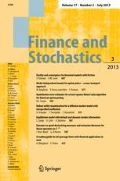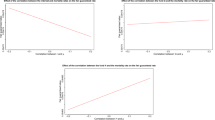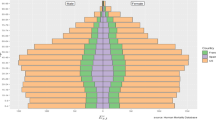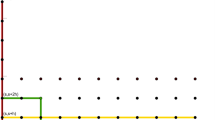Abstract
Similarly to the notion of modeling credit risk by using forward credit default spread rates, mortality risk in life insurance contracts is nowadays often modeled by using forward mortality (spread) rates. More recently, this concept has also been discussed for more complex life insurances that include multiple lives or intermediate states that correspond to the health status of the insured. For consistency purposes and for technical reasons, most authors assume that the underlying financial and demographic events are stochastically independent.
In the present paper, we study sufficient and necessary conditions under which general transition forward rates are indeed consistent with respect to the relevant insurance claims. This shows the theoretical limitations of the forward rate concept in life insurance. Our study is based on a model where the underlying financial and demographical developments are diffusion processes driven by a multivariate Brownian motion. This allows us to investigate independence properties by analyzing the asymptotic behavior of mixed (conditional) moments. In particular, we obtain that for joint life and disability insurance policies, some specific demographic events need to be dependent in order to ensure consistency.




Similar content being viewed by others
References
Bauer, D., Börger, M., Ruß, J., Zwiesler, H.-J.: The volatility of mortality. Asia-Pac. J. Risk Insur. 3, 184–211 (2008)
Bauer, D., Börger, M., Ruß, J.: On the pricing of longevity-linked securities. Insur. Math. Econ. 46, 139–149 (2010)
Bauer, D., Benth, F., Kiesel, R.: Modeling the forward surface of mortality. SIAM J. Financ. Math. 3, 639–666 (2012)
Bogachev, V.I.: Measure Theory, vol. I. Springer, Heidelberg (2007)
Buchardt, K.: Dependent interest and transition rates in life insurance. Insur. Math. Econ. 55, 167–179 (2014)
Cairns, A., Blake, D., Dowd, K.: Pricing death: frameworks for the valuation and securitization of mortality risk. ASTIN Bull. 36, 79–120 (2006)
Christiansen, M.C.: A joint analysis of financial and biometrical risks in life insurance. PhD thesis, University of Rostock (2007). urn:nbn:de:gbv:28-diss2007-0007-6, http://rosdok.uni-rostock.de
Christiansen, M.C.: Gaussian and affine approximation of stochastic diffusion models for interest and mortality rates. Risks 1, 81–100 (2013)
Cox, J., Ingersoll, J. Jr, Ross, S.: An intertemporal general equilibrium model of asset prices. Econometrica 53, 363–384 (1985)
Dahl, M.: Stochastic mortality in life insurance: market reserves and mortality-linked insurance contracts. Insur. Math. Econ. 35, 113–136 (2004)
Dahl, M., Møller, T.: Valuation and hedging of life insurance liabilities with systematic mortality risk. Insur. Math. Econ. 39, 193–217 (2006)
Haberman, S., Pitacco, E.: Actuarial Models for Disability Insurance. Chapman & Hall, Boca Raton (1999)
Ikeda, N., Watanabe, S.: Stochastic Differential Equations and Diffusion Processes. North-Holland, Amsterdam (1989)
Kloeden, P.E., Platen, E.: Numerical Solution of Stochastic Differential Equations. Springer, Heidelberg (1995). 2. corr. print. edition
Milevsky, M., Promislow, S.: Mortality derivatives and the option to annuitise. Insur. Math. Econ. 29, 299–318 (2001)
Miltersen, K., Persson, S.: Is mortality dead? Stochastic forward force of mortality rate determined by no arbitrage. Working paper, Norwegian School of Economics and Business Administration (2005). Online version available at http://www.mathematik.uni-ulm.de/carfi/vortraege/downloads/DeadMort.pdf
Norberg, R.: Forward mortality and other vital rates—are they the way forward? Insur. Math. Econ. 47, 105–112 (2010)
Tappe, S., Weber, S.: Stochastic mortality models: an infinite-dimensional approach. Finance Stoch. 18, 209–248 (2014)
Acknowledgements
Marcus Christiansen and Andreas Niemeyer acknowledge the financial support of the Deutsche Forschungsgemeinschaft (Research Grant: Regulation in the Financial Services Industry after the Crisis).
Author information
Authors and Affiliations
Corresponding author
Appendix
Appendix
Lemma A.1
Under Assumption 3.3 and with ϵ and (X(t)) t≥0 as in this assumption, we define for a fixed t with 0≤t≤u≤T ∗ and for i=1,…,n the processes \(\widetilde{X}_{i}(u) := X_{i}(u)-X_{i}(t)\). Then there exist
-
(a)
a random variable Y with \(\mathbb{E}[|Y|^{2(1+\epsilon )}] < \infty \) and
$$\begin{aligned} Y \ge\bigg| \prod\limits_{i=1}^n X_i(t_i)^{Z_i} \bigg| \mathrm{e} ^{- \sum_{i=1}^n \int_{T_i} X_i(u) \,\mathrm{d}u} \end{aligned}$$for all intervals T i ⊆[0,T ∗], Z i ∈{0,1} and t i ∈[0,T ∗] for i=1,…,n
and for all 0≤t≤T ∗ and \(x \in\mathbb{R}\) constants C(t,x) such that
-
(b)
\(\mathbb{E}_{\mathrm{Q}}^{(t,x)}[ | \int_{t}^{t+\varDelta }\widetilde{X}_{i}(u) \,\mathrm{d}u |^{k} ] \le C(t,x) \varDelta^{\frac{3}{2} k}\) for all Δ∈[0,T ∗−t] and \(k \in\mathbb{N}\).
-
(c)
\({\mathbb{E}_{\mathrm{Q}}^{(t,x)}[ \int_{t}^{t+\varDelta }\cdots\int_{t}^{s_{\ell-1}} \int _{t}^{s_{\ell}} { | \alpha_{i}(\tau,X_{i}(\tau)) - \alpha_{i}(\tau,X_{i}(t)) |} \,\mathrm{d} \tau\,\mathrm{d}s_{\ell}\cdots \mathrm{d}s_{1} ]}\hfill \le (\mathbb{E}_{\mathrm{Q}}^{(t,x)}[( \int_{t}^{t+\varDelta}\cdots \int_{t}^{s_{\ell-1}} \int _{t}^{s_{\ell}} { | \alpha_{i}(\tau,X_{i}(\tau)) - \alpha_{i}(\tau,X_{i}(t)) |} \,\mathrm{d} \tau\,\mathrm{d}s_{\ell}\cdots \mathrm{d}s_{1} )^{k}])^{\frac{1}{k}}\hfill \le C(t,x) \varDelta ^{\frac{3}{2} + \ell}\) for all \(\varDelta\in[0, T^{*}-t], \ell \in\mathbb{N}_{0}\).
-
(d)
\(\sqrt{\mathbb{E}_{\mathrm{Q}}^{(t,x)}[( \int _{t}^{t+\varDelta}\cdots\int_{t}^{s_{\ell -1}} \int_{t}^{s_{\ell}} \beta_{i}(\tau, X_{i}(\tau)) \,\mathrm {d}W_{i}(\tau) \,\mathrm{d} s_{\ell}\cdots \mathrm{d}s_{1} )^{2}]} \le C(t,x) \varDelta^{\frac{1}{2} + \ell}\) for all \(\varDelta\in[0, T^{*}-t], \ell\in\mathbb{N}_{0}\).
-
(e)
For all Δ∈[0,T ∗−t], let T i be an interval with T i ⊆[t,t+Δ], Z i ∈{0,1} and t i ∈[t,t+Δ] for all i=1,…,n. Then
$$\begin{aligned} &C(t,x) \varDelta^{\frac{9}{2}} \\ &\quad\ge \mathbb{E}_\mathrm{Q}^{(t,x)}\bigg[\bigg| \mathrm {e}^{- \sum_{i=1}^n \int_{T_i} \widetilde{X}_i(u) \,\mathrm{d}u} \prod_{i=1}^n X_i(t_i)^{Z_i} \\ & \qquad{}- \bigg( \prod_{i=1}^n X_i(t_i)^{Z_i} \bigg) \bigg( 1 - \sum _{i=1}^n \int_{T_i} \widetilde{X}_i(u) \,\mathrm{d}u + \frac{1}{2} \bigg(\sum _{i=1}^n \int_{T_i} \widetilde{X}_i(u) \,\mathrm{d}u \bigg)^2 \bigg) \bigg|\bigg]. \end{aligned}$$ -
(f)
\(| \frac{1}{\mathbb{E}_{\mathrm{Q}}^{(t,x)}[\mathrm{e}^{-\int _{t}^{t+\varDelta}\widetilde{X}_{i}(\tau) \,\mathrm{d}\tau } ]} -1 - \mathbb{E}_{\mathrm{Q}}^{(t,x)}[\int_{t}^{t+\varDelta }\widetilde{X}_{i}(\tau) \,\mathrm{d}\tau ]\hfill + \frac{1}{2} \mathbb{E}_{\mathrm{Q}}^{(t,x)}[ ( \int _{t}^{t+\varDelta}\widetilde{X}_{i}(\tau) \,\mathrm{d}\tau)^{2} ] - ( \mathbb{E}_{\mathrm{Q}}^{(t,x)}[\int_{t}^{t+\varDelta }\widetilde{X}_{i}(\tau) \,\mathrm{d}\tau] )^{2} |\hfill \le C(t,x) \varDelta^{\frac{9}{2}}\) for sufficiently small Δ>0.
Proof
In the following, we write C(t,x)<∞ for any constant.
(a) A direct consequence from Hölder’s inequality for sums is the inequality
For each i=1,…,n, we have with (A.1) and the SDE (3.1) that
With this estimation, by applying Hölder’s inequality to the α-term and Doob’s inequality to the β-term, we get for k≥2 that
since X i (0) is deterministic. With Assumption 3.1(iii) for α i which is also true for the CIR process, we get
and this term is finite since analogously to Proposition 3.2, \(\mathbb{E}[ |X_{i}(u)|^{k}]\) is finite. By adding and subtracting an α-term, using (A.1) and by the same arguments as above, we obtain
In total, we get with Assumption 3.3(i) that
This random variable Y is integrable, since with Hölder’s inequality for \(p=\frac{1+\epsilon}{\epsilon}\),
by assumption and by the first part, where we distinguish the cases Z i =0 and Z i =1.
(b) First of all, we consider the case k>1. With Hölder’s inequality for p=k and Proposition 3.2, it follows that
The case k=1 also follows from the calculation above by skipping the second step.
(c) The first step is a direct consequence from Hölder’s inequality with parameter p=k. By applying ℓ+1 times Hölder’s inequality with p=k and using Assumption 3.1(ii), we get
using that \(\mathbb{E}_{\mathrm{Q}}^{(t,x)} [( |\widetilde {X}_{i}(\tau)|)^{k}] \le C(t,x) \varDelta^{\frac{k}{2}}\).
(d) By applying ℓ times Hölder’s inequality with p=2, the Itô isometry, Assumption 3.1(iii) and Proposition 3.2, we can show that the initial term is smaller than or equal to
(e) By a Taylor expansion, we have \(| \mathrm{e}^{-x} -1 + x - \frac{1}{2} x^{2} | \le\frac{1}{6} |x|^{3} \mathrm {e}^{-\xi}\) for ξ between 0 and x. Applying this approximation to \(x = \sum _{i=1}^{n} \int_{T_{i}} \widetilde{X}_{i}(u) \,\mathrm{d}u\) and using Hölder’s inequality with p=q=2 gives the inequality
We apply the generalization of Hölder’s inequality (cf. Corollary 2.11.5 in [4]) to the first factor with \(p_{i}=\frac{1}{n}\) and get that the expression from above is smaller than or equal to
where the first expression is bounded by (3.3). In the following, we use the inequality |e−ξ|≤1+e−2x for ξ between 0 and x and get that the expression is again smaller than or equal to
where we apply Hölder’s inequality to the second summand with the two parameters \(p= \epsilon_{0}^{-1}(1+\epsilon_{0})\) and q=1+ϵ 0, where ϵ 0 is chosen such that 0<ϵ 0≤ϵ and \(6 \frac{1+\epsilon_{0}}{\epsilon_{0}} \in\mathbb{N}\). The moments of the first two expected values are estimated by applying (b), and for the third expected value we plug in the definition of \(\widetilde {X}_{i}(u)\), take X i (t) out of the expected value and get by Assumption 3.3(i) that this expected value is finite.
(f) The Taylor approximation of second order gives us that
where ξ 1 is between 0 and \(-\int_{t}^{t+\varDelta}\widetilde {X}_{i}(\tau) \,\mathrm{d}\tau\). Again, we use the Taylor approximation of second order and obtain
where ξ 2 is between 0 and y. We define
and get in total that
By using (b) and analogously to the proof of (e), we get
Analogously, we can show that \(|y| \le C(t,x) \varDelta^{\frac{3}{2}}\), and so we can make y arbitrarily small by choosing a small Δ. We get that |1+ξ 2|−4≤16 for all \(| \xi_{2} | \le|y| \le \frac{1}{2}\) and obtain the claim. □
Proposition A.2
For 0≤t≤T≤T ∗, let the mapping F as defined in Sect. 2 have a continuous derivative \(f=\frac{\mathrm{d}}{\mathrm{d}T} F\) in the second argument and let there be integrable random variables W and \(\widetilde{W}\) with
Given that \(\mathbb{E}_{\mathrm{Q}}[F(t,T,r,m) | \mathcal{F}_{t}] = F(t,T,\rho,\mu)\), we get
Proof
We have
From the definition of conditional expectations, we conclude for all \(A \in\mathcal{F}_{t}\) that
The second summand of the last line can be obtained by exchanging the order of integration with Fubini’s theorem, applying again the definition of conditional expectations and using again Fubini’s theorem. This is where we need the existence of the integrable upper bounds W and \(\widetilde{W}\). In total, we get for all T≥t that
Since f is continuous, the claim holds. □
Rights and permissions
About this article
Cite this article
Christiansen, M.C., Niemeyer, A. On the forward rate concept in multi-state life insurance. Finance Stoch 19, 295–327 (2015). https://doi.org/10.1007/s00780-014-0244-9
Received:
Accepted:
Published:
Issue Date:
DOI: https://doi.org/10.1007/s00780-014-0244-9
Keywords
- Forward mortality rate
- Multi-state life insurance
- Multiple default
- Moment estimates for diffusion processes
- Securitization of demographic risk




